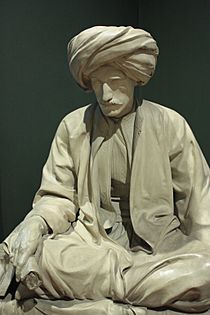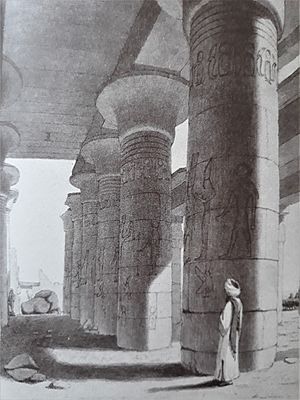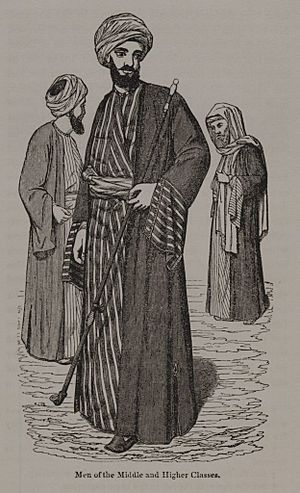Edward William Lane facts for kids
Quick facts for kids
Edward William Lane
|
|
|---|---|

Edward William Lane in an Ottoman outfit, plaster by Richard James Lane
|
|
| Born | 17 September 1801 Hereford, England
|
| Died | 10 August 1876 (aged 74) Broadwater, West Sussex, England
|
| Nationality | British |
| Known for | Arabic-English Lexicon |
| Scientific career | |
| Fields | Oriental studies |
Edward William Lane (born September 17, 1801 – died August 10, 1876) was a British expert on the Near East (called an orientalist), a translator, and a lexicographer (someone who writes dictionaries). He is famous for his books Manners and Customs of the Modern Egyptians and the Arabic-English Lexicon. He also translated One Thousand and One Nights and parts of the Kur-án.
During his life, Lane also wrote a detailed book about Egypt and its ancient sites. This book, called Description of Egypt, was published long after he died, in 2000.
Contents
Early Life
Edward William Lane was born in Hereford, England. He was the third son of Reverend Dr. Theopilus Lane. His great-uncle on his mother's side was the famous painter Thomas Gainsborough.
After his father passed away in 1814, Edward went to grammar school in Bath and then in Hereford. He was very good at mathematics. He visited Cambridge University but did not enroll there.
Instead, Lane moved to London to join his brother Richard. He studied engraving with him. At the same time, Lane started learning Arabic by himself. However, his health became poor. To improve his health and start a new career, he decided to travel to Egypt.
His Work
Travels in Egypt
Lane had several reasons for traveling to Egypt. He had been studying Arabic for a long time. Also, there was a huge interest in ancient Egypt (called egyptomania) in England. This was partly because of Giovanni Battista Belzoni's exhibition and a book by Vivant Denon. Lane's health was also getting worse in London, and he felt he needed a warmer place during the cold winter. In the 1800s, people who knew Arabic and were familiar with the Near East could easily find jobs with the British government. So, Lane sailed to Egypt on July 18, 1825.
He arrived in Alexandria in September 1825 and soon went to Cairo. He stayed in Egypt for two and a half years. During this time, he mixed with the local people, dressing like a Turk (from the then-powerful Ottoman Empire). He took many notes about his experiences and observations. In Old Cairo, he lived near Bab al-Hadid and studied Arabic with Sheikh Muhammad 'Ayyad al-Tantawi.
In Egypt, Lane visited coffee shops and local homes. He attended a mosque and learned a lot about Islam. He also became friends with other British travelers in Egypt, like John Gardner Wilkinson. Lane also took a trip down the Nile River to Nubia. He visited many ancient sites and wrote down his observations. On this trip, he saw places like Abydos, Dendera, Luxor, Kom Ombo, Philae, and Abu Simbel. Lane left Egypt on April 7, 1828.
Description of Egypt
Lane's interest in ancient Egypt might have started after seeing a presentation by Giovanni Battista Belzoni. His first goal was to write a book about the remaining parts of Ancient Egypt. A London publisher, John Murray, was interested in publishing this project, which Lane called Description of Egypt. However, Murray later decided not to publish it.
This was probably because the book had very detailed accounts of Egypt. It also included many illustrations and texts in Arabic, Ancient Egyptian (hieroglyphics), and Ancient Greek. All of this would have made the printing very expensive. Also, large books were becoming less popular, and Lane was not yet a well-known author. Because of money problems, Lane could not publish the book himself. So, it remained unpublished until the year 2000.
In Description of Egypt, Lane wrote about the places he visited in Egypt. He was very good at describing cities. He spent five chapters writing about everything in Cairo. This included how the city looked, details about Old Cairo, its monuments, and the nature around it. He also wrote about rural areas.
Lane also discussed Egypt's landscape and geography. This included its deserts, the Nile River, Egyptian farming, and the climate. One whole chapter was about the political history of Egypt, especially the history of Muhammad Ali of Egypt.
Lane's Description of Egypt mostly focuses on Ancient Egypt. Even though he wasn't called an Egyptologist during his lifetime, his book followed the style of Egyptology. The book had an extra section called On the Ancient Egyptians. In this part, Lane talked about where Egyptians came from, their looks, their civilization, hieroglyphics, Ancient Egyptian religion, laws, priests, kings, and daily life. He also wrote about their buildings, sculptures, farming, and trade. Lane once wrote that he had to try very hard to stay away from studying Ancient Egypt. He said it fascinated him so much that it would distract him from his main work.
Lane spent 32 days at the Giza pyramid complex. He drew, sketched, and took notes for his book. At Giza, Lane saw workers taking stones from the Great Sphinx of Giza to use for new buildings. He stayed in the Valley of the Kings for 15 days, sleeping in the tomb of Ramses X. He wrote detailed notes about each tomb. Lane believed there might be more hidden tombs in the Valley.
His book included 160 illustrations.
Manners and Customs of the Modern Egyptians
Since Lane had trouble publishing his Description of Egypt, a publisher named John Murray suggested he expand one chapter into a separate book. This became Manners and Customs of the Modern Egyptians (1836). The book was very popular and is still printed today. It helped Lane become well-known in the field of Orientalism.
Lane wrote very detailed accounts of daily life in Egypt in the 19th century. These notes have been very helpful for researchers later on. A century after Lane, a scholar named Arthur John Arberry visited Egypt. He said it felt like visiting a different planet because many things Lane wrote about were no longer there.
Lane knew that his research was limited because men and women were kept separate. This meant he couldn't get a close look at the lives of Egyptian women. This was something his readers were very interested in. He had to rely on information from Egyptian men. To get more information, he later asked his sister, Sophia Lane Poole, to come to Egypt. She could visit places only women were allowed, like harems and bathhouses, and report what she found. This led to a book called The Englishwoman in Egypt, which included much of Lane's own unpublished work, but written from his sister's point of view.
The One Thousand and One Nights
Lane's next big project was translating One Thousand and One Nights, also known as Arabian Nights. His translation first came out in parts from 1838 to 1840. It was then published as a three-volume set in 1840. A new version was released in 1859. His detailed notes for the book were published after he died, in 1883, by his great-nephew Stanley Lane-Poole.
People have different opinions about how good Lane's translation is. Some say it is much better than other English versions because it is accurate and truly captures the spirit of the original stories. Others say his writing style is too grand or too simple and sometimes hard to read.
Lane himself thought the Nights was a very educational book. He once wrote that if there had been a good translation of it with helpful notes, he might not have needed to write his book about Egyptian manners and customs.
Dictionary and Other Works
From 1842 onwards, Lane spent most of his time working on a huge project: the Arabic-English Lexicon. This was a very large Arabic-English dictionary. He did find time to write some articles for a German journal. In 1842, he went to Egypt again with his wife, two children, and his sister Sophia Lane Poole. His sister was working on her book, The Englishwoman in Egypt. This time, Lane stayed in Egypt for seven years, working six days a week on his Lexicon. A local scholar, Ibrahim al-Disqui, helped him. Al-Disqui found manuscripts and checked them for Lane. They became close friends.
Lane's Selections from the Kur-án was published in 1843. It was not very popular and had many printing mistakes. This was because Lane was in Egypt at the time, collecting materials for his Arabic-English Lexicon.
Lane was not able to finish his dictionary completely. He had reached the letter Qāf, which is the 21st letter of the Arabic alphabet, when he passed away in 1876. His great-nephew Stanley Lane-Poole finished the work using Lane's notes. He published the rest of the dictionary over the next twenty years.
In 1854, a book called The Genesis of the Earth and of Man was published without an author's name. It was edited by Lane's nephew Reginald Stuart Poole. Some people believe Lane wrote this book.
A part of Description of Egypt that focused on Cairo's early history and geography was updated by Reginald Stuart Poole in 1847. It was published in 1896 as Cairo Fifty Years Ago.
Personal Life
Edward William Lane came from a family of notable Oriental scholars. His sister, Sophia Lane Poole, was also an Oriental scholar. His nephew Reginald Stuart Poole and his great-nephew Stanley Lane-Poole were also famous scholars and archaeologists. His brother, Richard James Lane, was a well-known engraver and artist.
In 1840, Lane married Nafeesah, a Greek-Egyptian woman. He had taken her in and educated her when she was about eight years old, and they later married.
Edward William Lane passed away on August 10, 1876. He was buried at West Norwood Cemetery. His writings and drawings are kept in the archive of the Griffith Institute at the University of Oxford.
Biographies
- Ahmed, Leila (1978). Edward W Lane. London: Longman.
- Lane-Poole, Stanley (1877). Life of Edward William Lane. London: Williams and Norgate.
- Thompson, Jason (2010). Edward William Lane: The Life of the Pioneering Egyptologist and Orientalist, 1801-1876. Cairo: American University in Cairo Press.
See also
 In Spanish: Edward William Lane para niños
In Spanish: Edward William Lane para niños



